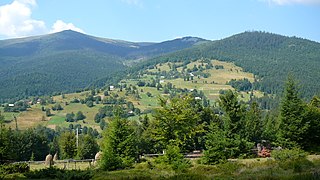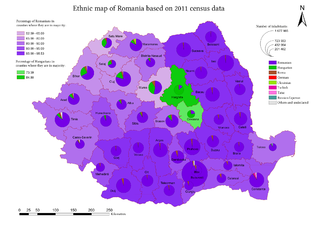This article covers the history and bibliography of Romania and links to specialized articles.

Transylvania is a historical region in central Romania. To the east and south its natural border is the Carpathian Mountains, and to the west the Apuseni Mountains. Broader definitions of Transylvania also encompass the western and northwestern Romanian regions of Crișana and Maramureș, and occasionally Banat.

Transylvania County is a county in the U.S. state of North Carolina. As of the 2020 Census the population is 32,986. Its county seat is Brevard.

Cluj-Napoca, or simply Cluj, is the fourth-most populous city in Romania. It is the seat of Cluj County in the northwestern part of the country. Geographically, it is roughly equidistant from Bucharest, Budapest and Belgrade. Located in the Someșul Mic river valley, the city is considered the unofficial capital of the historical province of Transylvania. From 1790 to 1848 and from 1861 to 1867, it was the official capital of the Grand Principality of Transylvania.
Following the outbreak of World War II on 1 September 1939, the Kingdom of Romania under King Carol II officially adopted a position of neutrality. However, the rapidly changing situation in Europe during 1940, as well as domestic political upheaval, undermined this stance. Fascist political forces such as the Iron Guard rose in popularity and power, urging an alliance with Nazi Germany and its allies. As the military fortunes of Romania's two main guarantors of territorial integrity—France and Britain—crumbled in the Fall of France, the government of Romania turned to Germany in hopes of a similar guarantee, unaware that the then-dominant European power had already granted its blessing to Soviet claims on Romanian territory in a secret protocol of 1939's Molotov–Ribbentrop Pact.

Târgu Mureș is the seat of Mureș County in the historical region of Transylvania, Romania. It is the 16th largest Romanian city, with 134,290 inhabitants as of the 2011 census. It lies on the Mureș River, the second longest river in Romania.

The term Greater Romania usually refers to the borders of the Kingdom of Romania in the interwar period, achieved after the Great Union. It also refers to a pan-nationalist idea.

Alba Iulia is a city that serves as the seat of Alba County in the west-central part of Romania. Located on the Mureș River in the historical region of Transylvania, it has a population of 63,536.

Transylvania University is a private university in Lexington, Kentucky. It was founded in 1780 and was the first university in Kentucky. It offers 46 major programs, as well as dual-degree engineering programs, and is accredited by the Southern Association of Colleges and Schools. Its medical program graduated 8,000 physicians by 1859.

John Sigismund Zápolya or Szapolyai was King of Hungary as John II from 1540 to 1551 and from 1556 to 1570, and the first Prince of Transylvania, from 1570 to his death. He was the only son of John I, King of Hungary, and Isabella of Poland. John I ruled parts of the Kingdom of Hungary with the support of the Ottoman Sultan Suleiman; the remaining areas were ruled by Ferdinand I of Habsburg, who also ruled Austria and Bohemia. The two kings concluded a peace treaty in 1538 acknowledging Ferdinand's right to reunite Hungary after John I's death, though shortly after John Sigismund's birth, and on his deathbed, John I bequeathed his realm to his son. The late king's staunchest supporters elected the infant John Sigismund king, but he was not crowned with the Holy Crown of Hungary.
Transylvania has had different names applied to it in several traditions.

Gelou was the Vlach ruler of Transylvania at the time of the Hungarian conquest of the Carpathian Basin around 900 AD, according to the Gesta Hungarorum. Although the Gesta Hungarorum, which was written after 1150, does not indicate the enemies of the conquering Hungarians (Magyars) known from earlier annals and chronicles, it refers to local rulers—including Gelou—who are not mentioned in other primary sources. Consequently, historians debate whether Gelou was a historical person or an imaginary figure created by the unidentified author of the Gesta Hungarorum. In Romanian historiography, based on the mention of him by Anonymus some 300 years later, Gelou is considered one of three early-10th-century Romanian dukes with lands in the intra-Carpathian region of present-day Romania.

The Székely Land or Szeklerland is a historic and ethnographic area in Romania, inhabited mainly by Székelys, a subgroup of Hungarians. Its cultural centre is the city of Târgu Mureș (Marosvásárhely), the largest settlement in the region.

Michael the Brave, born as Mihai Pătrașcu, was the Prince of Wallachia, Prince of Moldavia (1600) and de facto ruler of Transylvania. He is considered one of Romania's greatest national heroes. Since the 19th century, Michael the Brave has been regarded by Romanian nationalists as a symbol of Romanian unity, as his reign marked the first time all principalities inhabited by Romanians were under the same ruler.
Transylvania is a historical region in central and northwestern Romania. It was under the rule of the Agathyrsi, part of the Dacian Kingdom, Roman Dacia (106–271), the Goths, the Hunnic Empire, the Kingdom of the Gepids, the Avar Khaganate, the Slavs, and the 9th century First Bulgarian Empire. During the late 9th century, Transylvania was reached and conquered by the Hungarian conquerors, and Gyula's family from seven chieftains of the Hungarians ruled Transylvania in the 10th century. King Stephen I of Hungary asserted his claim to rule all lands dominated by Hungarian lords, and he personally led his army against his maternal uncle Gyula III. Transylvania became part of the Kingdom of Hungary in 1002, and it belonged to the Lands of the Hungarian Crown until 1920.

The Principality of Transylvania was a semi-independent state ruled primarily by Hungarian princes. Its territory, in addition to the traditional Transylvanian lands, also included the other major component called Partium, which was in some periods comparable in size with Transylvania proper. The establishment of the principality was connected to the Treaty of Speyer. However, Stephen Báthory's status as king of Poland also helped to phase in the name Principality of Transylvania. It was usually under the suzerainty of the Ottoman Empire, although the principality often had dual vassalage in the 16th and 17th centuries.
The Edict of Torda was a decree that authorized local communities to freely elect their preachers in the Eastern Hungarian Kingdom of John Sigismund Zápolya. The delegates of the Three Nations of Transylvania – the Hungarian nobles, Transylvanian Saxons, and Székelys – adopted it at the request of the monarch's Antitrinitarian court preacher, Ferenc Dávid, in Torda on 28 January 1568. Though it did not acknowledge an individual's right to religious freedom, in sanctioning the existence of a radical Christian religion in a European state, the decree was an unprecedented act of religious tolerance.

The Hungarian minority of Romania is the largest ethnic minority in Romania, consisting of 1,227,623 people and making up 6.1% of the total population, according to the 2011 Romanian census, the second last recorded in the country's history.

Hotel Transylvania is a 2012 American computer-animated monster comedy film produced by Columbia Pictures and Sony Pictures Animation. The first installment in the Hotel Transylvania franchise, it was directed by Genndy Tartakovsky from a screenplay by Peter Baynham and Robert Smigel and a story by Todd Durham, Dan Hageman, and Kevin Hageman. The film stars the voices of Adam Sandler, Andy Samberg, Selena Gomez, Kevin James, Fran Drescher, Steve Buscemi, Molly Shannon, David Spade and CeeLo Green.

Hotel Transylvania 2 is a 2015 American computer-animated monster comedy film directed by Genndy Tartakovsky, written by Robert Smigel and Adam Sandler, and it is the second installment in the Hotel Transylvania franchise and the sequel to Hotel Transylvania (2012). Produced by Sony Pictures Animation, it was animated by Sony Pictures Imageworks, with an additional funding provided by LStar Capital.















